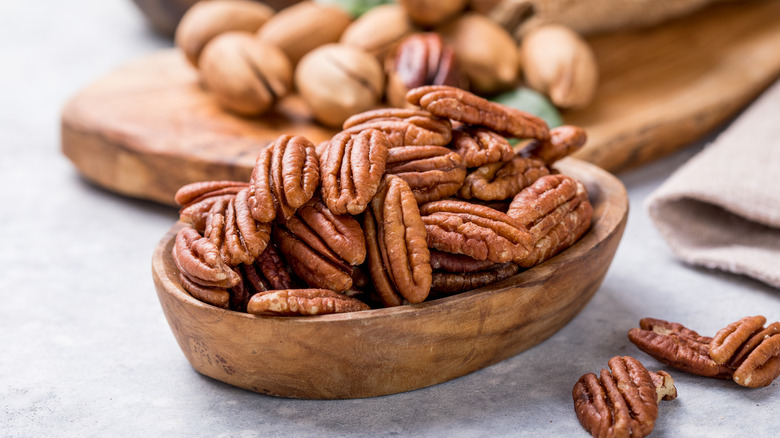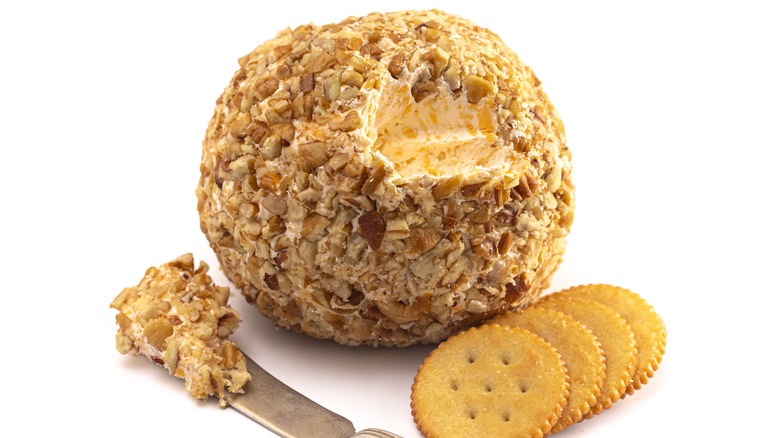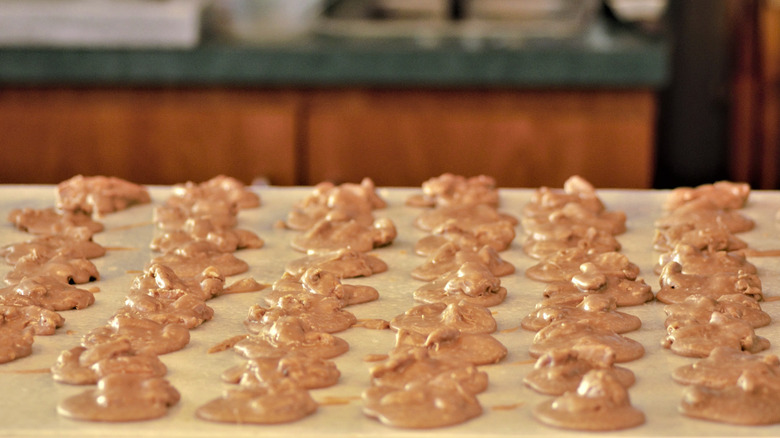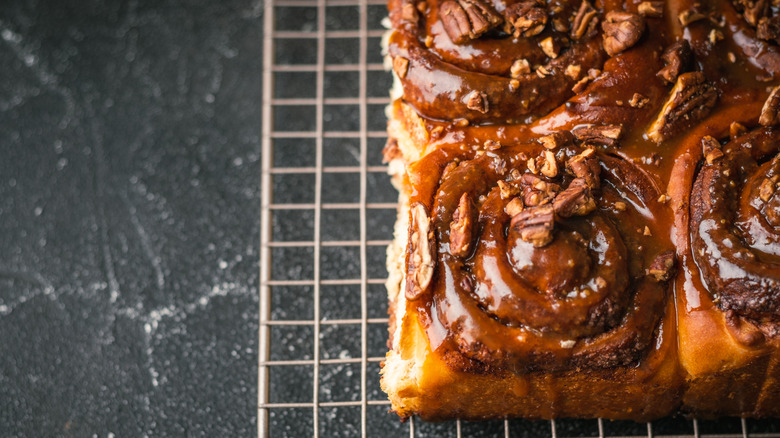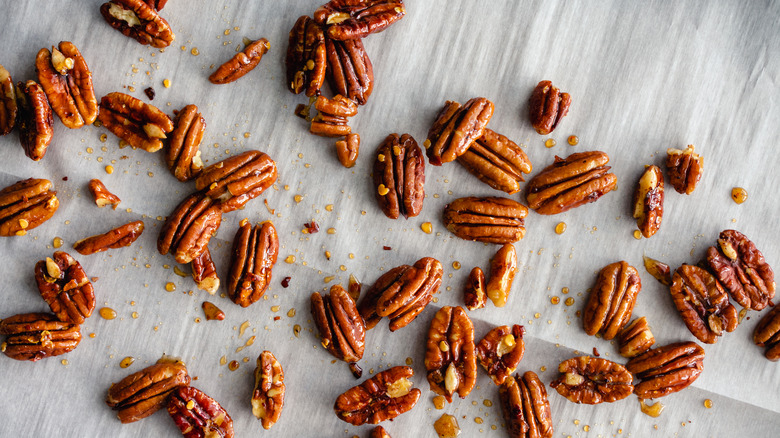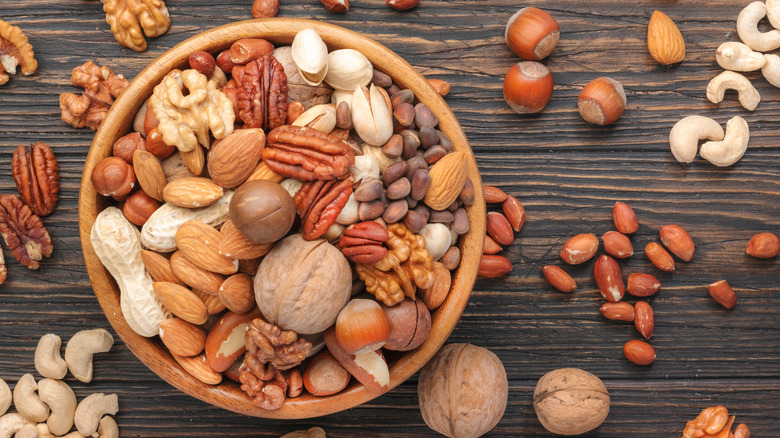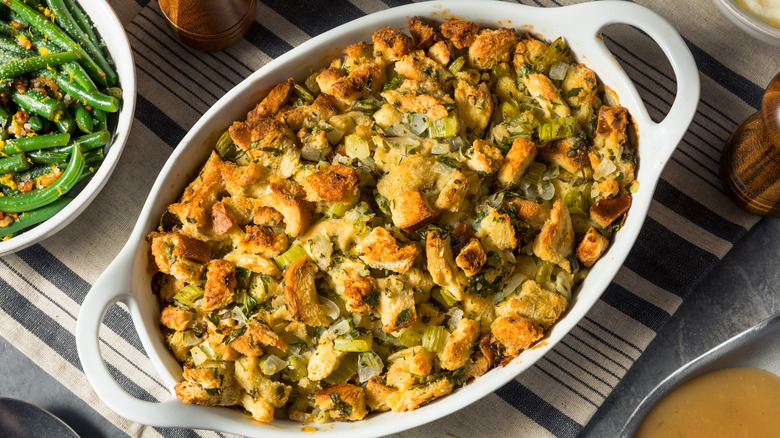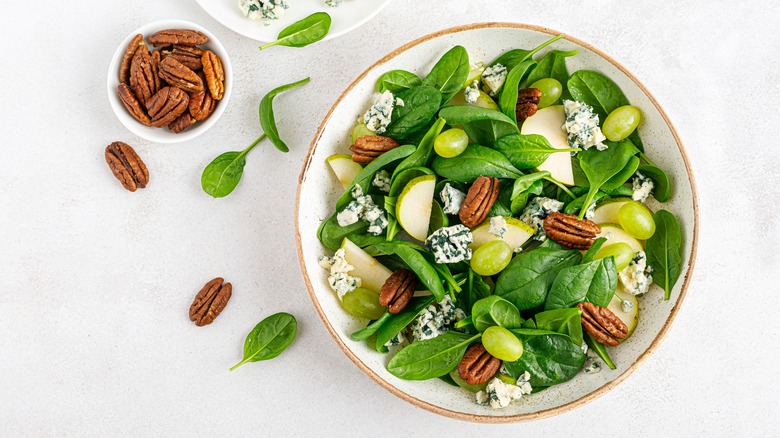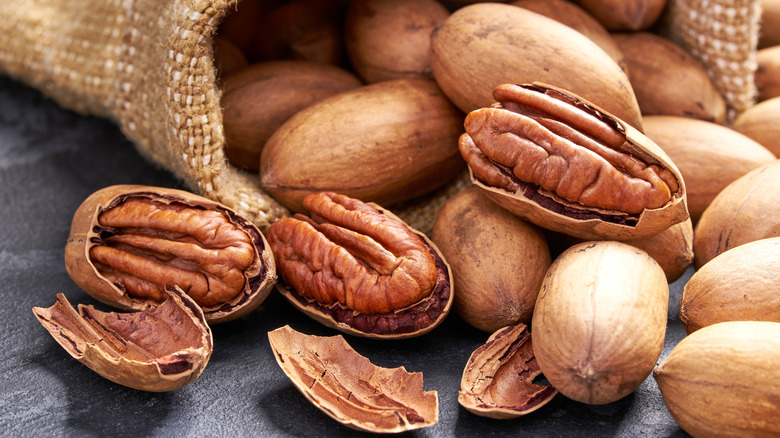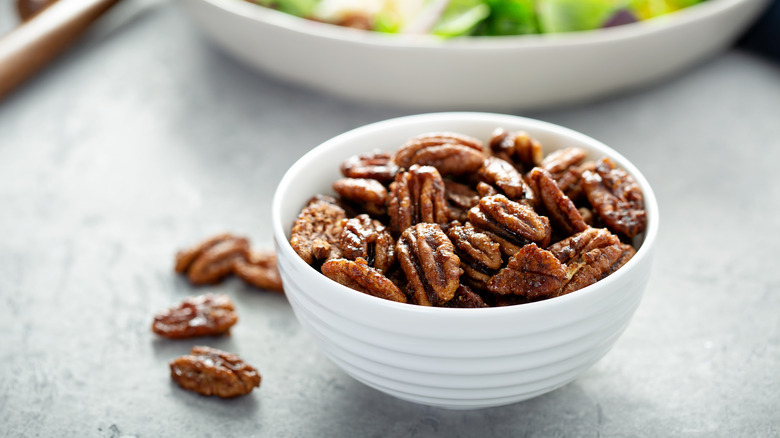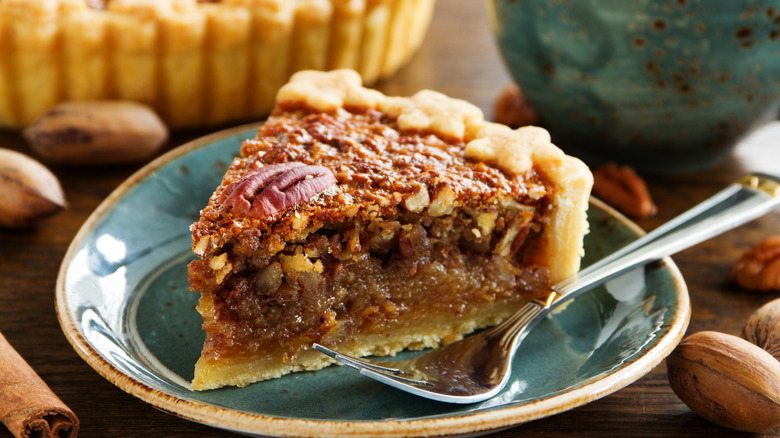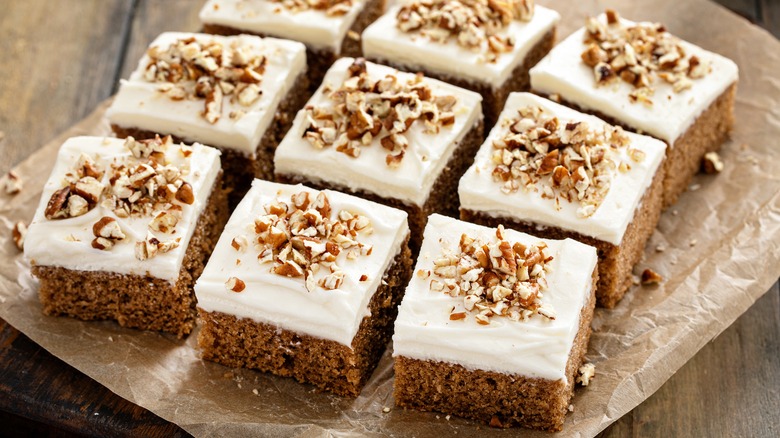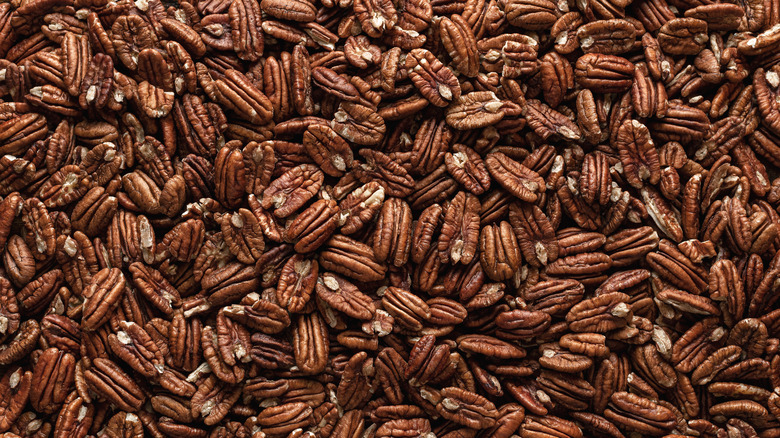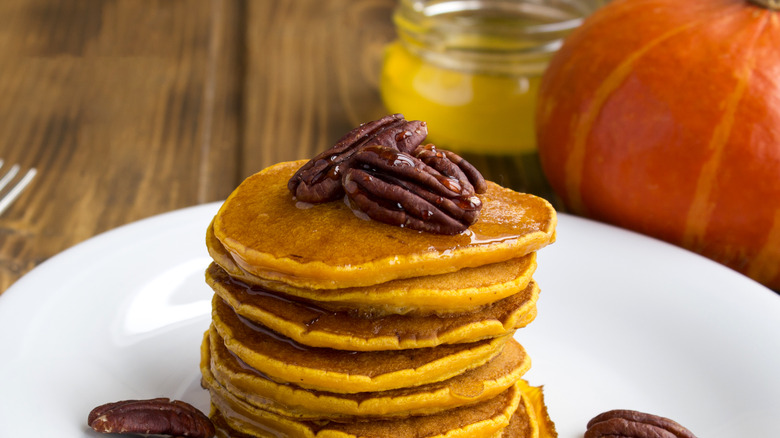13 Types Of Pecans, Explained
We may receive a commission on purchases made from links.
Pecans, a distant cousin of the walnut, are widely used in the culinary world for everything from sweet cookies and pies to savory crunchy coatings and toppings. The toasty, buttery flavor of pecan is like no other, and the distinctive taste is beloved by cooks everywhere.
Pecans are grown widely in the Southern United States, and between 80% and 90% of the world's pecans come from the U.S., per Cane River Pecan Company. The Native Americans were the first to harvest the native-growing pecans and many varieties are named after the various tribes that are associated with them. Pecans, like walnuts, have some of the highest oil and fat content of any nut, which not only makes them more aromatic but also contributes to a tender-yet-crisp texture (via On Food and Cooking). Read on to learn more about the various varieties of pecans and the best culinary uses for each.
Stuart
The Stuart pecan is the most commonly cultivated variety in Georgia due to its particular taste and texture. The Stuart has a "firm texture with a rich delicate flavor" (via Georgia Pecan Farms), and is also considered to have a "classic, slightly sweet" taste, per Hudson Pecan. This makes the Stuart ideal for use in savory recipes, like charcuterie boards, or as a coating for a cheese ball. Because it's one of the older varieties of pecan grown in the United States, the shell is thicker and a bit tougher to crack (newer varieties have been bred to have thinner shells).
If you seek out this special variety, try to make sure to get them already shelled to save yourself some time and trouble. While thin or "paper-shelled" pecans are easy enough to crack with your bare hand, hard-shelled varieties like the Stuart can have a "discernibly sweeter taste," according to Nuts.com.
Candy
One of the most common uses for pecans in the culinary world is candy making, and the Candy pecan may just be the best choice for this type of cooking. The Candy variety of pecans was originally cultivated specifically for use in, you guessed it, candy and other confections. Five-generation pecan farmers, the Millicans of Millican Pecan, have made cultivating and harvesting pecans their family's mission in life. According to the Millicans, Candy pecans have "good flavor and paper-thin shells." Although this variety has become less popular over time as new varieties and cultivars have become available, there are still some smaller farms in the South that continue to grow this sweet type of pecans.
Down in the South, pecan praline candy is practically a way of life, and over time, the recipe morphed into simple candied pecans. There are a few easy ways to make candied pecans, and if you can get your hands on some Candy pecans for this recipe, all the better.
Mahan
This variety of pecan is an older cultivar with a somewhat ambiguous origin. Thought to have originated from a seed planted in 1910, the Mahan pecan is the parent of many other kinds of pecans, some of which are on this list. It is also one of the largest cultivars of pecan (some can exceed a size 2 ½ inches long), which makes it great for recipes with a decorative, whole-nut design. Mahan pecans are a "paper shell" variety, which means the shell has been cultivated specifically for easy cracking and shelling.
Mahan pecans are "richly flavored and can be enjoyed either in pecan confections or straight out of your hand" (via Stuckey's). With such a flavor-packed pecan, the uses can extend far beyond consuming them plain. Pecan sticky buns and cinnamon rolls are the perfect places to use Mahan pecans, as the depth of flavor can stand up well to the competing elements of caramel and spices.
Farley
In the world of pecans, some varieties are commonly found and others are a bit rare. Farley pecans are on the rare side, and according to one of the farms that do grow them, Camp David Pecans, the Farley pecan is hard to find because the tree matures later in the year and is favored by wild critters who prefer the thin shell. Discovered in 1918 in Florida, the Farley pecan is "sweet, beautiful, thin-shelled, [and] easy to hand crack," (via Camp David Pecans).
The unique (to this variety) grooves of the Farley pecan are well suited to holding onto seasonings, like spices or sugar mixtures. The meat itself has a "rich, nutty flavor," according to Pecan Nation. The deep flavor of the Farley pecan would work very well in a salad with many other competing flavor elements, and the crunchy texture won't get soggy from vinaigrettes and dressings.
Sioux
Another pecan variety named for the Native American tribe known to have first harvested them, the Sioux pecan is a very light color and mild flavor, compared to some darker varieties. Larry Stein, a horticulturist at Texas A&M University, believes that "of all named cultivars to date, one of those with the best eating quality is the Sioux." It is one of the most commonly grown varieties in Texas, and while it may be hard to find, many generic bags of pecans from this area likely have Sioux pecans mixed in.
This relatively small nut would work well in batches of mixed nuts, where a larger-sized pecan would overwhelm the others. Whether raw, toasted, or candied, the Sioux pecan is ideal for whole-nut applications of all kinds. Known to have a particularly pleasant texture, this variety is better suited to these types of recipes than other varieties that may have a more astringent flavor due to darker skin or larger size.
Prilop of Lavaca
Hailing from Lavaca County, Texas, the Prilop of Lavaca pecan is a smaller nut, but that doesn't mean it isn't high-quality. It's a true native variety and was originally found growing wild near the Lavaca river. This variety won the State Champion Native award at the Texas Pecan Show in 1991 for its quality and flavor. It can be hard to find commercially because of the smaller size of the nut, but home growers will have a lot of success with this type.
While the Prilop of Lavaca is a smaller nut, it has an "outstanding flavor, texture, and appearance," (via Camp David Pecans). Because this nut is considered a "best all-around," there really is no limit to the applications. Pecan recipes of all kinds would be appropriate for the Prilop, from raw recipes like salads to baked goods like brownies. Even moist dishes (think Thanksgiving stuffing) would be perfect for the Prilop due to its crunchy texture.
Oconee
Another fantastic Texan pecan is the Oconee. It's a relatively new variety, only cultivated for the first time in 1989, according to the University of Georgia, though Native Americans were harvesting this type as far back as the 1500s. The Oconee pecan is a "large pecan with a unique flavor, a little sweet but also savory," (via Georgia Pecan Farms). This variety has a high resistance to cold temperatures and may more likely be found in those regions.
Pecans with both sweet and savory flavor profiles do particularly well in salads where there are also sweet and savory flavor elements to play off of. Salads with a combination of salty cheese and sweet fruit (like a Waldorf or classic blue cheese and pear salad) are the type of dish that would work perfectly with Oconee pecans. Not everybody likes nuts in their chicken salad, but a classic chicken salad with crisp apples and celery is another great place for this type.
Forkert
Another great variety of pecan for eating raw is the Forkert. The Forkert variety is a cross between the Success and Schley varieties, per Bass Pecan Trees. While some pecan varieties have tough, thick shells, the Forkert has a "paper shell" that makes it a great candidate for in-shell sales of the pecan. Gift packs and other in-shell sales of pecans are often this variety.
According to a guide to pecan cultivars put out by Auburn University, Forkert pecan trees consistently produce "very high-quality kernels with bright color and good taste." If you see yourself enjoying some pecans roasted at home, using a nutcracker to open them right into the palm of your hand, the Forkert variety is a top option. If, however, your pecans are destined to be shipped unshelled, packing material can tend to find its way into the grooves of the nut, according to Pecan South Magazine.
Caddo
Originally developed just 100 years ago in 1922, the Caddo pecan is a cross between the Brooks and Alley cultivars, says Camp David Pecans. The Caddo variety is an exceptionally flavorful pecan (not unlike the Elliott) and it is characterized by its "high quality, medium-sized, slender, beautifully golden kernel, packed with yummy natural flavor," per Camp David Pecans. The great flavor of the Caddo comes from the high level of the natural oil found in the nut as the oil contains a lot of the compounds that contribute to taste and smell.
This oil produces an exceptional aroma when toasted, which makes this a particularly great option for savory applications, like in a salad or crusting a piece of fish. Any nut high in natural oil is prone to burning, so keep a close eye while toasting. Toasting in the oven (versus a sauté pan) is the best option for complete, even browning without burning.
Kanza
Kanza pecans are named after the Kanza tribe of Native Americans who gave their name to the state of Kansas, and the tribe continues to operate a pecan farm in Oklahoma to this day. The Selman Nut Company sells Kanza pecans by name, and recommends them for use in raw or baked applications for the "bright golden color and great flavor." Though not the absolute best-tasting pecan in existence, the flavor is more than adequate for a tasty pecan pie (possibly with the help of an unexpected ingredient).
After a rigorous examination of taste and texture by the American Society for Agricultural Science, the Kanza pecan was more favored in a blind taste test than even some native (meaning non-clone) Southern varieties, even though it's a "common notion for some in the pecan industry... that native pecans taste better." While the taste difference between native and cloned varieties of pecan may be negligible to the average person, Kanza pecans are definitely a great pick for most applications.
Cape Fear
Named for a river that runs through North Carolina, the Cape Fear pecan is a relatively new variety to the nut world. According to a plant profile done by North Carolina State University, the Cape Fear pecan (which was originally cultivated at the college) is a particularly precocious variety and the nuts from this tree are "crunchy and have a buttery flavor."
Cape Fear pecans are known to have a thin exterior with a "superb, nutty flavor" that, when shelled, are "perfect and shell out almost exclusively as halves," (via Brickyard Point Farms). Pecans with a flavor profile that leans heavily on nuttiness can stand up well to baked goods where delicate flavors can get lost or muddled amongst the other competing ingredients, like sugar, butter, and spices. Carrot cake, pecan pie, and even some flavors of ice cream would all be ideal recipes to use Cape Fear pecans.
Schley
The Schley variety is a particularly prolific pecan, and there are even Eastern and Western varieties of Schley. The Schley pecan has a long history in the Southern United States and is commonly sold at markets and farm stands across the state. This variety has also contributed to many of the other cultivars on this list and is considered by some to be the "father" of many current pecan varieties.
According to pecan farmers, Pearson Farm, the Schley pecan is "easily cracked by hand, and the kernel is plump and oily." Oilier varieties of pecan are particularly useful for grinding into nut flour or pressing into homemade nut oil. Nut oils typically have a low tolerance for heat, but are particularly useful for cold applications like vinaigrettes or simply drizzling on a soup. Pecan oil would work exceptionally well drizzled on a nice bowl of warm butternut squash soup.
Elliot
Rounding out the list of pecan varieties is the Elliott. The Elliott pecan is considered by pecan farmers and researchers as one of the highest-quality cultivars of pecan grown in the United States. According to research done by the University of Georgia, the Elliott pecans' "quality and flavor are excellent" and they sell for top dollar due to their "excellent cracking ability, outstanding color and flavor, and consistent nut quality from year to year," (via the University of Georgia).
Unlike other varieties that emerged as crosses of existing trees, the Elliott grew from a seedling and is named after the owner of the property it first grew on. This pecan variety boasts a sweet and buttery smooth flavor with a crisp bite and would pair very well in a sweet recipe like butterscotch or sticky toffee pudding. All pecans benefit from at least a light toasting to bring out the aroma of the nut's natural oils.
